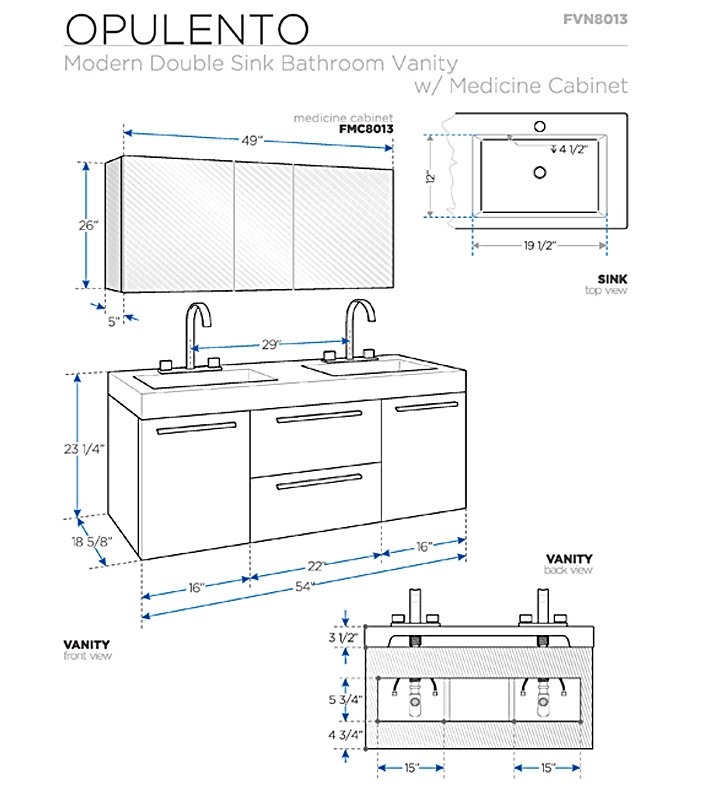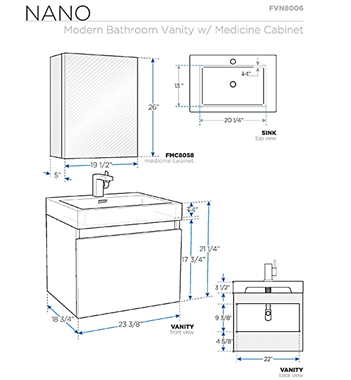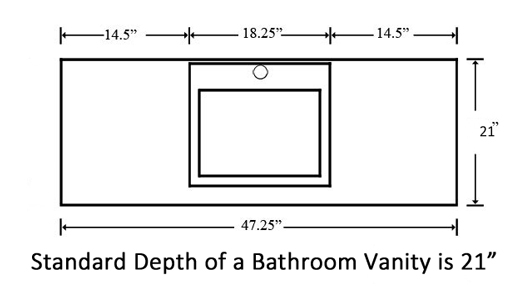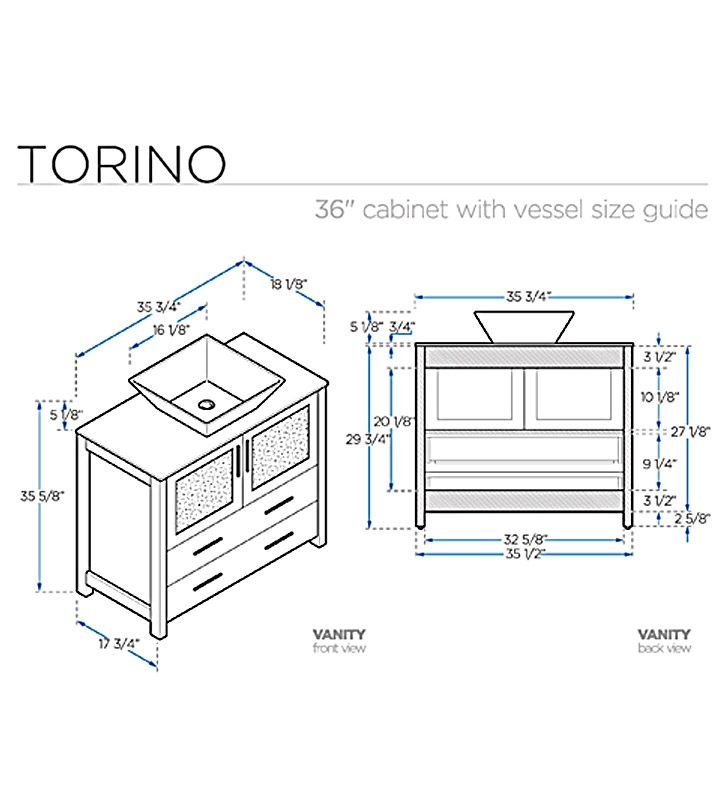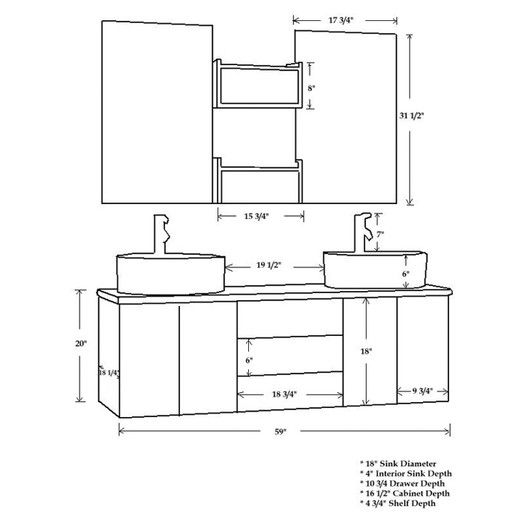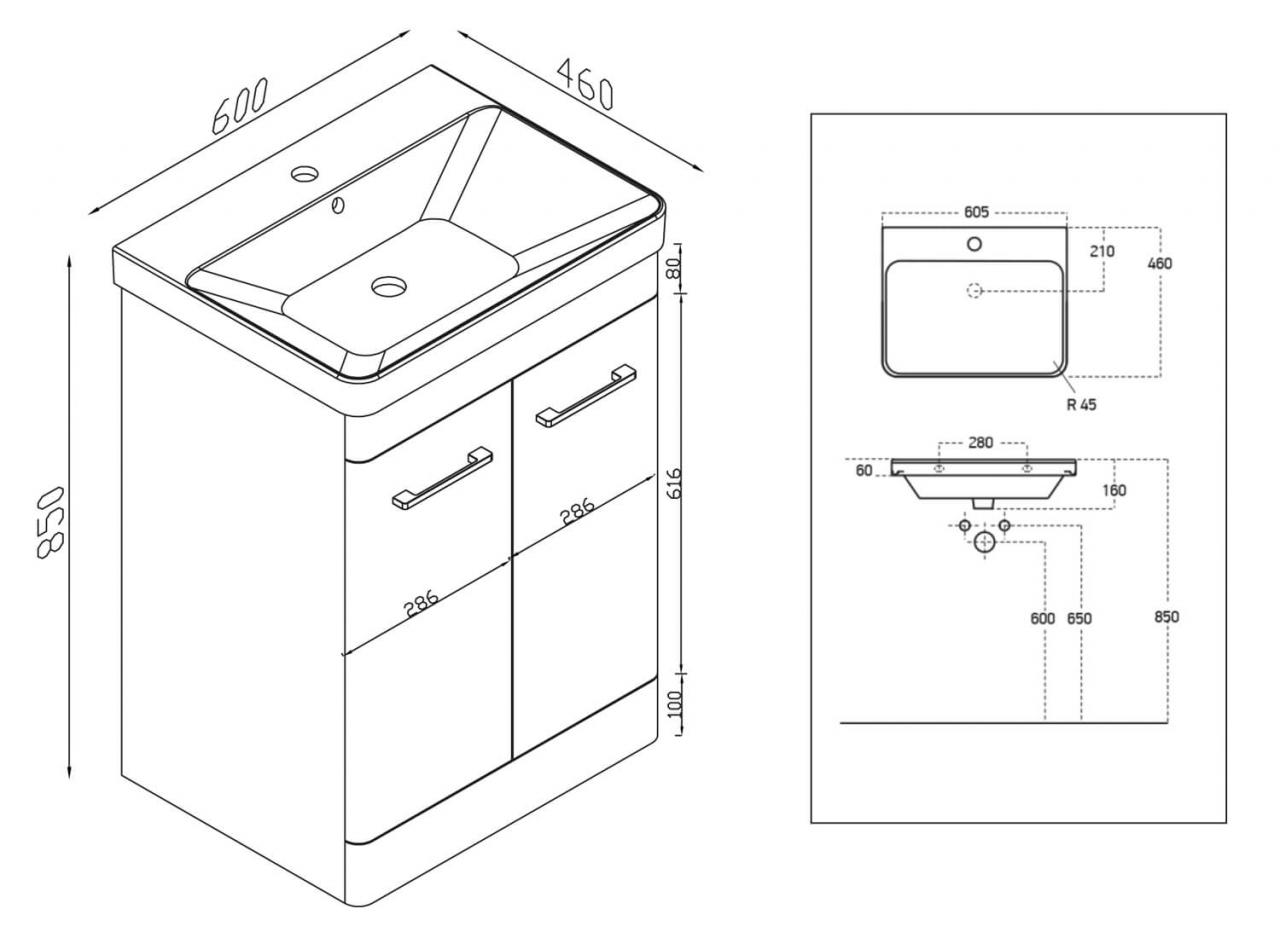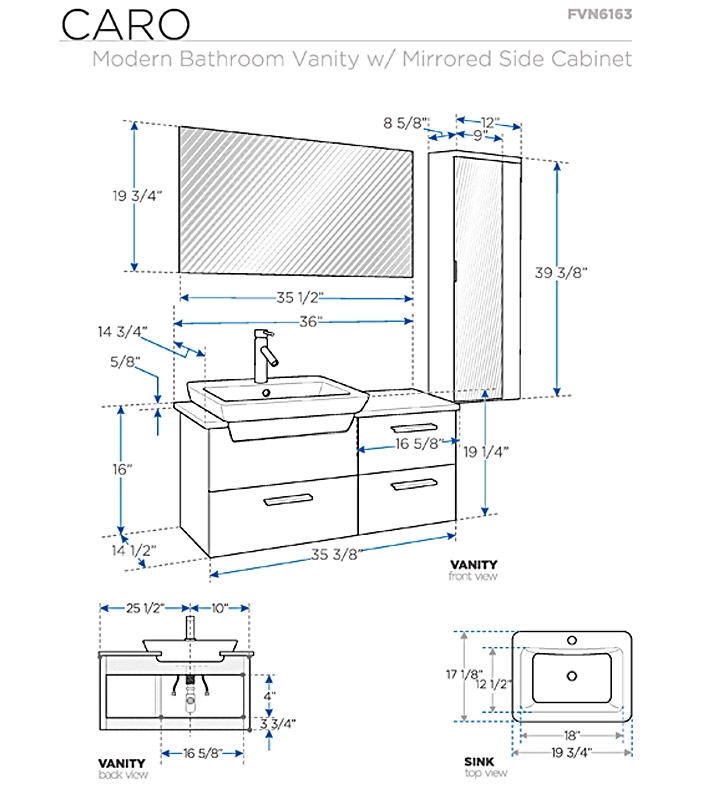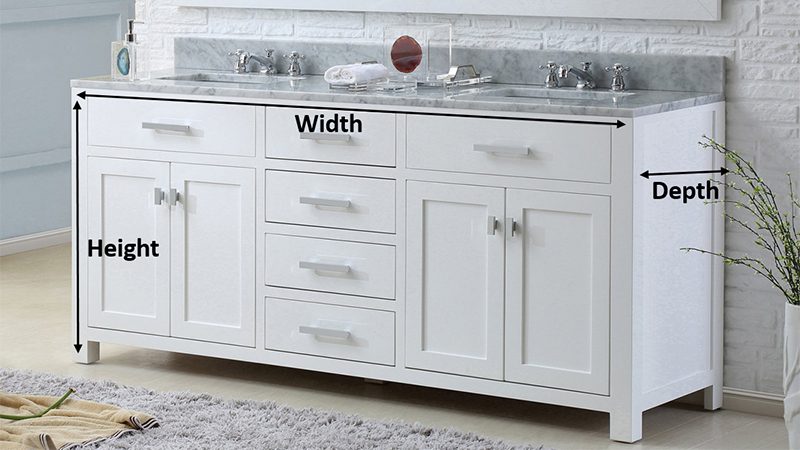Bathroom Vanity Unit Dimensions
Standard Dimensions for Bathroom Vanity Units
When it comes to designing or remodeling a bathroom, choosing the right vanity unit dimensions is crucial for both functionality and aesthetics. Standard dimensions for bathroom vanity units can vary depending on factors like available space, plumbing requirements, and personal preferences. Here are some typical dimensions to consider:
- Width: The standard width for a bathroom vanity unit typically ranges from 24 to 72 inches. Smaller vanities are suitable for compact bathrooms or powder rooms, while larger widths offer more countertop space and storage options for master bathrooms or shared spaces.
- Depth: The standard depth for a bathroom vanity unit is around 20 to 22 inches. This depth provides sufficient space for the countertop, sink, and plumbing fixtures while ensuring comfortable use and ease of access.
- Height: The standard height for a bathroom vanity unit ranges from 30 to 36 inches. This height is designed to accommodate most adults comfortably while standing. However, taller individuals may prefer a custom-height vanity for added convenience.
- Countertop Overhang: A typical countertop overhang for a bathroom vanity unit is around 1 to 1.5 inches. This overhang allows for comfortable use of the sink and provides space for mounting faucets or accessories.
- Sink Placement: The sink is usually centered within the width of the vanity unit, with the faucet positioned directly above it. Standard sink sizes vary, but common dimensions include 16 to 20 inches in diameter for round sinks and 18 to 24 inches in width for rectangular sinks.

Factors to Consider When Choosing Bathroom Vanity Unit Dimensions
Choosing the right dimensions for your bathroom vanity unit involves considering several factors to ensure a functional and visually appealing design. Here are some key factors to keep in mind when selecting vanity unit dimensions:
Available Space: Measure the available space in your bathroom to determine the maximum size for your vanity unit. Consider the layout of the room, including the placement of doors, windows, and other fixtures, to ensure that the vanity fits comfortably without obstructing traffic flow or interfering with other elements.
Plumbing Requirements: Consider the location of existing plumbing lines and fixtures when choosing vanity unit dimensions. Ensure that there is sufficient space to accommodate plumbing connections, including drainage pipes, water supply lines, and trap assemblies. This may influence the depth and configuration of the vanity unit.
User Preferences: Take into account the preferences and needs of the primary users when selecting vanity unit dimensions. Consider factors such as height, reach, and storage requirements to ensure that the vanity is comfortable and convenient to use daily.
Storage Needs: Determine the amount of storage space required for toiletries, towels, and other bathroom essentials. Choose a vanity unit with adequate drawer, cabinet, or shelf space to accommodate your storage needs without overcrowding the countertop or sacrificing functionality.
Design Style: Consider the overall design style and aesthetic of your bathroom when selecting vanity unit dimensions. Choose dimensions that complement the architectural features, color scheme, and decor elements of the space to create a cohesive and harmonious design.
Future Resale Value: Keep in mind the potential impact of vanity unit dimensions on the resale value of your home. Opt for dimensions that are in line with industry standards and appeal to a broad range of potential buyers to maximize the value and marketability of your property.
Common Variations in Bathroom Vanity Unit Sizes
While standard dimensions provide a useful starting point for choosing a bathroom vanity unit, there are also common variations in sizes to accommodate different design preferences and space constraints. Here are some common variations in bathroom vanity unit sizes:
Compact Vanities: Compact vanities are ideal for small bathrooms, powder rooms, or tight spaces where floor space is limited. These vanities typically have widths ranging from 18 to 30 inches and may feature a single sink or a narrower profile to maximize space efficiency.
Double Vanities: Double vanities are popular in master bathrooms or shared spaces where multiple users need their own space. These vanities typically have widths ranging from 48 to 72 inches and feature two sinks with ample countertops and storage space for each user.
Corner Vanities: Corner vanities are designed to fit into tight corners or awkward spaces where a standard vanity may not fit. These vanities typically have a triangular or L-shaped configuration and may feature a single sink or double sinks depending on the available space.
Floating Vanities: Floating vanities are mounted directly to the wall, creating a sleek and modern look while maximizing floor space. These vanities can vary in width and height to accommodate different design preferences and storage needs.
Custom Vanities: Custom vanities are tailored to fit specific dimensions or design requirements and offer unlimited flexibility in terms of size, shape, and configuration. These vanities can be designed to fit any space, from small alcoves to expansive master bathrooms, and can incorporate unique features or materials to reflect your personal style.
Vessel Sink Vanities: Vessel sink vanities are designed to accommodate above-counter sinks, which sit on top of the vanity rather than being recessed into the countertop. These vanities may have shallower depths and taller heights to accommodate the height of the vessel sink and faucet.
Optimal Spacing and Clearance for Bathroom Vanity Units
In addition to choosing the right dimensions for your bathroom vanity unit, it’s essential to consider optimal spacing and clearance to ensure a comfortable and functional design. Proper spacing and clearance around the vanity unit allow for ease of use, accessibility, and maintenance. Here are some guidelines to follow:
Clearance Around the Vanity: Allow for adequate clearance around the vanity unit to ensure easy access and movement within the space. Aim for a minimum clearance of 30 inches in front of the vanity and at least 18 inches of clearance on either side to allow for comfortable use and access to drawers, doors, and plumbing fixtures.
Clearance for Doors and Drawers: Ensure that there is sufficient clearance for doors and drawers to open fully without obstruction. Leave at least 3 inches of space between the vanity and adjacent walls or fixtures to allow for the smooth operation of doors and drawers.
Clearance for Plumbing Fixtures: Allow for clearance around plumbing fixtures such as faucets, drains, and supply lines to ensure proper installation and maintenance. Position the vanity unit to provide easy access to plumbing connections while minimizing the risk of damage or interference.
Countertop Overhang: Leave a slight overhang of 1 to 1.5 inches around the edges of the countertop to prevent water from dripping onto the floor and to provide space for mounting faucets or accessories.
Height Considerations: Ensure that the height of the vanity unit is appropriate for the intended users. Standard vanity heights range from 30 to 36 inches, but taller individuals may prefer a custom-height vanity for added comfort and convenience.
Accessibility: Consider the needs of all users, including children, elderly individuals, and individuals with mobility challenges, when planning the layout of the bathroom. Ensure that the vanity unit is accessible and easy to use for everyone by incorporating features like adjustable height countertops, accessible storage solutions, and easy-to-reach fixtures.
Customization Options for Tailoring Bathroom Vanity Unit Dimensions
While standard dimensions provide a useful starting point for selecting a bathroom vanity unit, customization options allow you to tailor the dimensions to fit your specific needs and preferences. Whether you’re working with a small space, an unconventional layout, or unique design requirements, customizing the dimensions of your vanity unit can help you achieve the perfect fit. Here are some customization options to consider:
Custom Width and Depth: Work with a custom cabinetry or furniture maker to create a vanity unit with dimensions that fit your space perfectly. Customizing the width and depth of the vanity allows you to maximize space efficiency and create a design that seamlessly integrates with the rest of the room.
Adjustable Shelves and Drawers: Incorporate adjustable shelves and drawers into your vanity unit design to maximize storage flexibility and accommodate items of various sizes. Adjustable shelves and drawers allow you to customize the storage configuration to suit your needs and preferences.
Integrated Features: Consider incorporating integrated features into your vanity unit design to enhance functionality and convenience. Examples include built-in electrical outlets, USB charging ports, pull-out organizers, and built-in lighting options.
Unique Materials and Finishes: Explore unique materials and finishes to add personality and style to your vanity unit. Consider options like reclaimed wood, exotic hardwoods, custom finishes, or decorative accents to create a one-of-a-kind design that reflects your taste and complements the overall aesthetic of your bathroom.
Custom Sink Options: Choose a sink that fits your space and design preferences, whether it’s a traditional undermount sink, a vessel sink, or a custom-designed basin. Custom sink options allow you to create a unique focal point and add visual interest to your vanity unit.
Tailored Height: Consider customizing the height of your vanity unit to suit your specific needs and preferences. Taller individuals may prefer a vanity with a higher countertop height for added comfort and convenience, while shorter individuals may benefit from a lower countertop height for ease of use.
IKEA Hemnes / Rättviken Single Vanity – 2 Drawers Dimensions
IKEA Hemnes / Törnviken Open Double Sink Cabinet Dimensions
Bathroom Vanities Buy Bathroom Vanity Furniture u0026 Cabinets RGM
What’s the Standard Depth of a Bathroom Vanity?
Bathroom Vanities Buy Bathroom Vanity Furniture u0026 Cabinets RGM
Cambridge Plumbing Moonstone 59″ Double Bathroom Vanity Set
Bathroom Vanities Dimensions & Drawings
Joseph Miles Eve Floor Standing 850mm Height Vanity Unit
Bathroom Vanities Buy Bathroom Vanity Furniture
Choosing a Bathroom Vanity: Sizes, Height, Depth, Designs
Related Posts:
- Antique White Bathroom Vanity Set
- Bathroom Vanity Tops With Integrated Sink
- Offset Bathroom Vanity
- Redoing A Bathroom Vanity
- Pedestal Bathroom Vanity
- Japanese Style Bathroom Vanity
- Bathroom Vanity Unit Dimensions
- 60″ Bathroom Vanity Without Top
- Bathroom Vanity Replacement Globes
- Bathroom Vanity Stools With Wheels
